The Art of Ceramic Pottery
People all over the world love ceramics, not just for their practical uses but also as a powerful way to express themselves. Pottery holds a special place in many cultures. From ancient times to today’s modern designs, this craft has become a timeless art form that crosses all borders. In Belize, a country rich in cultural heritage, handcrafted pottery beautifully showcases this legacy. While exploring local artisans, we stumbled upon Cecilia Ceramics—a business that masterfully combines traditional craftsmanship with modern creativity. At the heart of this vibrant collection is Victoria Bedran, whose unique approach breathes new life into this ancient art. Here’s her story.
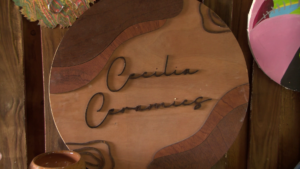 Sabreena Daly, Reporting
Sabreena Daly, Reporting
In Belize, our love for clay pottery goes way back to the ancient Maya civilization. For the Maya, pottery wasn’t just practical—it was a powerful cultural and spiritual symbol. They crafted beautifully intricate pieces for cooking, storage, and ceremonies, often decorating them with detailed carvings and meaningful symbols. Victoria Bedran, inspired by this rich history, wanted to connect the past with the present. After studying pottery at university, she came back to Belize with a passion to share her modern techniques and knowledge. She blends the ancient art form with her own contemporary creativity, bringing a fresh twist to this timeless craft.
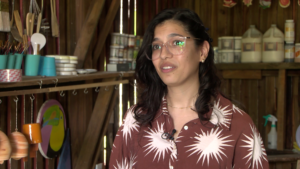
Victoria Bedran
Victoria Bedran, Owner, Cecilia Ceramics
“I went to school in England, that’s when I discovered different media, about collage, clay, plaster molds, glass, and all sorts of woodworking. I went into all of those media, and I found out that clay was best suited for me, and I loved it. I loved how you can work with earth, water, fire, air, like all of the elements of the earth to create one piece. I’ve always wanted to be an artist. I loved art my whole life. So when I discovered ceramics, I fell in love more with it. And I wanted to bring that to Belize, because I never really experienced clay. I know the Mayans use clay, but I wanted to bring a different part of it here in Belize. I also wanted to be a teacher, so the teaching thing was part of that too.”
Pottery, like many art forms, offers a therapeutic way to express and reconnect with oneself. For Bedran, pottery became her sanctuary. After realizing that teaching and the typical nine-to-five grind weren’t her calling, she returned to her craft and rediscovered her passion. This sparked the creation of her own business, Cecilia Ceramics, where she could fully embrace her love for pottery and turn it into a thriving creative outlet.
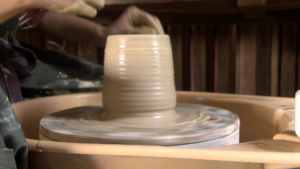 Victoria Bedran
Victoria Bedran
“You know, sometimes I don’t even feel like an entrepreneur. I just feel like I’m somebody doing what they love and I get paid for it sometimes. It’s a passion of mine and I enjoy sharing it with other people and seeing their face being happy with what I’ve made makes me feel great. It is very therapeutic, sometimes stressful, but mostly therapeutic. Making, getting a lump of clay and making anything out of your mind that you can do, the possibilities are endless. So, it’s just the thought of sitting down and just creating something that comes to mind or a vision or something on Pinterest you’ve always wanted and can’t afford, you could just do it out of clay. Even when you’re on the wheel, that motion of spinning and everything in the center and you’re just in the zone, it’s sort of relaxing for me.”
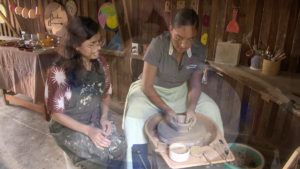 The process starts with raw clay mixed with water to create ‘slip,’ a thin, sticky mixture. This slip is passed through a sieve to remove any impurities, then spread on a plaster slab to dry slightly, making it easier to handle. Once it reaches the perfect consistency, the clay is ‘wedged,’ much like kneading dough. Today, we watched as Victoria expertly prepped her clay, working it as if she were kneading a loaf of bread. Next, the clay is shaped on a potter’s wheel, with water helping to mold it into the desired form. This is one of the most enjoyable stages—I even got to try my hand at the wheel! After shaping, the piece is left to dry for about a week, reaching the ‘leather-hard’ stage. At this point, the clay becomes firm enough for trimming and refining, allowing for additional details like handles or decorative elements to be added, enhancing the piece’s final appearance.
The process starts with raw clay mixed with water to create ‘slip,’ a thin, sticky mixture. This slip is passed through a sieve to remove any impurities, then spread on a plaster slab to dry slightly, making it easier to handle. Once it reaches the perfect consistency, the clay is ‘wedged,’ much like kneading dough. Today, we watched as Victoria expertly prepped her clay, working it as if she were kneading a loaf of bread. Next, the clay is shaped on a potter’s wheel, with water helping to mold it into the desired form. This is one of the most enjoyable stages—I even got to try my hand at the wheel! After shaping, the piece is left to dry for about a week, reaching the ‘leather-hard’ stage. At this point, the clay becomes firm enough for trimming and refining, allowing for additional details like handles or decorative elements to be added, enhancing the piece’s final appearance.
Victoria Bedran
“After it’s dried to bone dry, I’ll put it in the kiln and it will get fired for 12 hours.”
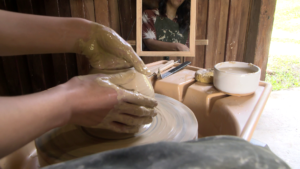 Sabreena Daly
Sabreena Daly
“And we are currently firing some items today.”
Victoria Bedran
“Yes, This is a homemade gas kiln that I bought. And we are currently firing the first set of bisque firing, it’s called. So that’s whenever the clay turns into ceramics. Right now we’re candling at below 100 degrees Celsius. I candle it for five hours just to make sure all the moisture is out of the clay before I start turning up the heat because if I turn up the heat and there’s still moisture in the clay it will explode.”
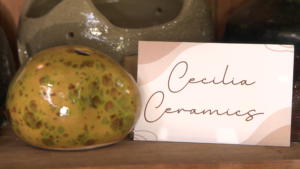 Victoria carries on the tradition of the ancient Mayans, placing small “kiln gods” by the kiln door to protect her pottery, a practice believed to prevent cracking or explosions during firing. Inside the ceramic oven are charming trinket trays and additional commissioned items.
Victoria carries on the tradition of the ancient Mayans, placing small “kiln gods” by the kiln door to protect her pottery, a practice believed to prevent cracking or explosions during firing. Inside the ceramic oven are charming trinket trays and additional commissioned items.
Sabreena Daly
“Now, these items on display went through the same process you just described. I want to get a look at these, though. These are so adorable. Look at that. You said something really funny that your customers would tell you.”
Victoria Bedran
“They don’t need a bottle stopper because they drink the whole bottle. But I said it would be good for gifts.”
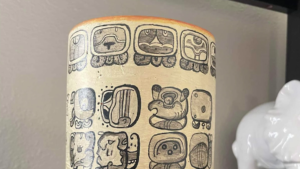 Sabreena Daly
Sabreena Daly
“That’s really funny. But I love the detail. This literally has a roughness like the tentacle.”
Victoria Bedran
“I do markets around Belize. I go with Market on the Go and Wonderland. So it’s mostly in San Ignacio, Belmopan night markets; I go to Placencia sometimes and then I also post on my social media about new products I make. My social media is Cecilia’s Ceramics.”
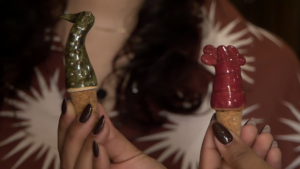 For Bedran, handcrafting each ceramic piece is a true labor of love, with every detail shaped with passion and care. It’s this connection to her work that brings her so much joy. Yet, her greatest hope is that the joy she feels in creating her pieces is passed on to those who bring them into their homes, adding not just beauty and warmth, but a personal touch that makes each piece feel like a special part of their story. Looking on the Bright Side, I’m Sabreena Daly.
For Bedran, handcrafting each ceramic piece is a true labor of love, with every detail shaped with passion and care. It’s this connection to her work that brings her so much joy. Yet, her greatest hope is that the joy she feels in creating her pieces is passed on to those who bring them into their homes, adding not just beauty and warmth, but a personal touch that makes each piece feel like a special part of their story. Looking on the Bright Side, I’m Sabreena Daly.







Facebook Comments